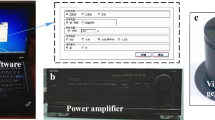Abstract
This paper presents an active piezoelectric sensing system for concrete crack detection that is based on the energy diffusivity method. The feasibility of using the energy diffusivity of ultrasound to characterize the structural integrity of a pavement is first analyzed. Experiments are then carried out to evaluate the performance of this approach to crack detection. In addition, the detectable range of this system is studied by testing it with cuttings at different angles and different distances between sensor and actuator. Results show that by analyzing the energy diffusivity density of the sensor responses, cracks in the concrete specimen can be detected. This crack detection system can be used in highway and airport pavement slabs for pavement health monitoring applications.














Similar content being viewed by others
References
Fujita Y, Mitani Y, Hamamoto Y (2006) A method for crack detection on a concrete structure. In: The 18th international conference on pattern recognition
Fujita Y, Hamamoto Y (2011) A robust automatic crack detection method from noisy concrete surface. Mach Vis Appl 22:245–254
Ito A, Aoki Y, Hashimoto S (2002) Accurate extraction and measurement of fine cracks from concrete block surface image. Ind Electron Soc 3:2202–2207
Abdel-Qader I, Abudayyeh O, Kelly ME (2003) Analysis of edge-detection techniques for crack identification in bridges. J Comput Civil Eng 7(4):255–263
Seung-Nam Yu, Jang J-H, Han C-S (2006) Auto inspection system using a mobile robot for detecting concrete cracks in a tunnel. Auto Constr 16(2007):255–261
Yamaguchi T, Hashimoto S (2006) Automated crack detection for concrete surface image using percolation model and edge information. In: IEEE industrial electronics, IECON 2006, 32nd annual conference on, 3355–3360
Sinha SK, Fieguth PW (2006) Automated detection of cracks in buried concrete pipe images. Auto Constr 15(2006):58–72
Song G, Haihang G, Mo Y-L (2008) Smart aggregates: multi-functional sensor for concrete structures-a tutorial and a review. Smart Mater Struct 17(2008):1–17
Gu H, Moslehy Y, Sanders D, Song G, Mo YL (2010) Multi-functional smart aggregate-based structural health monitoring of circular reinforced concrete columns subjected to seismic excitations. Smart Mater Struct 19:065026 (, p 7)
Quinn W, Kelly G, Barrett J (2012) Development of an embedded wireless sensing system for the monitoring of concrete. Struct Health Monit 11:381–392
Zhang Y (2006) In situ fatigue crack detection using piezoelectric paint sensor. J Intell Mater Syst Struct 2006(17):843
Chong KP, Carino NJ, Washer G (2003) Health monitoring of civil infrastructures. Smart Mater Struct 12(2003):483–493
Shin SW et al (2008) Piezoelectric sensor based nondestructive active monitoring of strength gain in concrete. Smart Mater Struct 17:1–8
Wait JR, Park G, Farrar CR (2005) Integrated structural health assessment using piezoelectric active sensors. Shock Vib 12(6):389–405
Park S, Ahmad S, Yun C-B, Roh Y (2006) Multiple crack detection of concrete structures using impedance-based structural health monitoring techniques. Exp Mech 46:609–618
Zhu J, He L (2011) Piezoelectric actuator/sensor wave propagation based nondestructive active monitoring method of concrete structures. J Wuhan Univ Technol Mater 26(3):541–547
Zhu J, Gao C, He L (2012) Piezoelectric-based crack detection techniques of concrete structures: experimental study. J Wuhan Univ Technol Mater 27(2):346–352
Anugonda P, Wiehn JS, Turner JA (2001) Diffusion of ultrasound in concrete. Ultrasonic J A 39(6):429–435
Deroo F, Kim J-Y, Qu J, Sabra K, Jacobs LJ (2010) Detection of damage in concrete using diffuse ultrasound. J Acoust Soc Am 127(6):3315–3318
Anugonda P, Wiehn JS, Turner JA (2001) Diffusion of ultrasound in concrete. Ultrasonics 39(2001):429–435
Turner J (1998) Diffusion of ultrasound in concrete. J Acoust Soc Am 104(3):1790
Ramamoorthy SK, Kane Y, Turner JA (2004) Ultrasound diffusion for crack depth determination in concrete. J Acoust Soc Am 115(2):523–529
Weaver RL (1990) Diffusivity of ultrasound in polycrystals. J Mech Phys Solids 38(1):55–86
Weaver RL (1998) Ultrasonics in an aluminum foam. Ultrasonics 36(1–5):435–442
Kee S-H, Zhu J (2013) Using piezoelectric sensors for ultrasonic pulse velocity measurements in concrete. Smart Mater Struct 22:115016 (, p 11)
Demirboga R, Turkmen I, Karakoc MB (2004) Relationship between ultrasonic velocity and compressive strength for high-volume mineral-admixtured concrete. Cem Concr Res 34(2004):2329–2336
Ye G, Lura P, van Breugel K, Fraaij ALA (2004) Study on the development of the microstructure in cement-based materials by means of numerical simulation and ultrasonic pulse velocity measurement. Cement Concr Compos 26:491–497
Schubert F, Koehler B (2004) Numerical time-domain simulation of diffusive ultrasound in concrete. Ultrasonics 42(1):781–786
Casten RG, Holland CJ (1978) Instability results for reaction diffusion equations with Neumann boundary conditions. J Differ Equ 27(2):266–273
Acknowledgments
The authors would like to thank the US Federal Aviation Administration Airport Pavement R&D Section (Grant#: 2013G022) for funding support. The contents of the paper do not necessarily reflect the official views or policies of the FAA. The paper does not constitute a standard, specification, or regulation.
Author information
Authors and Affiliations
Corresponding author
Rights and permissions
About this article
Cite this article
Zhang, C., Yu, X., Alexander, L. et al. Piezoelectric active sensing system for crack detection in concrete structure. J Civil Struct Health Monit 6, 129–139 (2016). https://doi.org/10.1007/s13349-015-0143-6
Received:
Revised:
Accepted:
Published:
Issue Date:
DOI: https://doi.org/10.1007/s13349-015-0143-6




